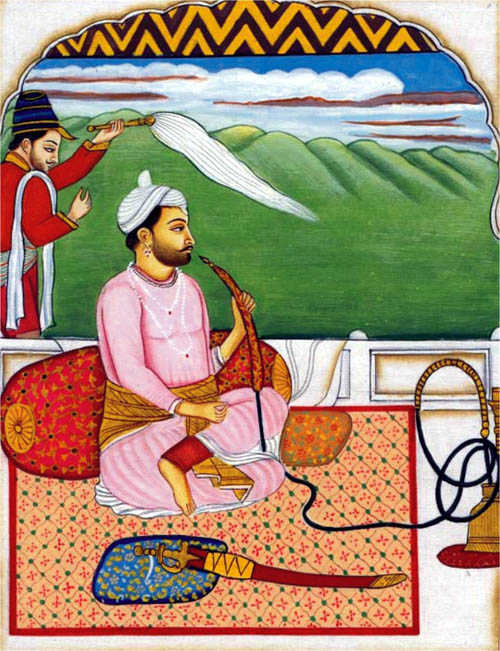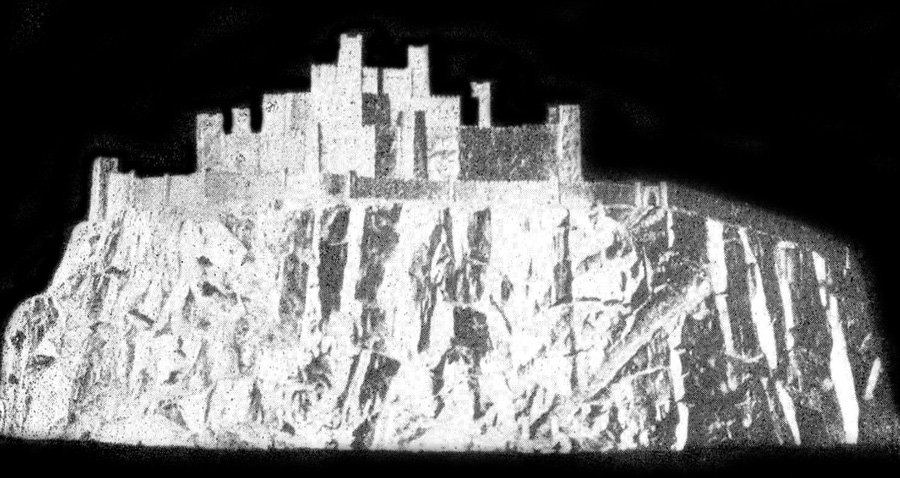
Silver model of Kangra Fort
- 70 million stamped royal Dirhams (gold-coins)
- A house of silver (length 30 yards by breadth 15 yards), which could be dismantled piece by piece and put together again. The roof was made of pure carved silver and the 8 supporting pillars were made of solid gold and silver (4 pillars each) which had been cast in moulds.
- 700 maans (one maan equal 40 kg) of Gold and Silver plates.
- 400 maans of pure gold ingots.
- 2000 maans of Silver bullion.
- 30 maans of various jewels (pearls, rubies diamonds corals etc.)
- Clothes studded with gems.
- Rolls of carpets and fine cloth of Sus and linen of Rum.
- The idol of the Katoch clan Goddess and her canopy of gold (this vast booty of the Katoch Kings had been collected by them for hundreds of generations).
After loading the booty on camels, the Sultan returned to Ghazni where he displayed his loot to the citizens of Ghazni. It is believed that he ordered the idol of Ambika Mata to be cut and made into weights to measure beef (cow-meat), the base of the idol was crushed and sprinkled on the path which leads to the Mecca-Madina. The gold canopy of the goddess was melted and turned into the Sultans bathing tub.
Rajanaka Jagdish Chandra bid his time and in the year A.D. 1033 his son Indu Chandra gave his two daughters in marriage to Anant Deva the Raja of Kashmir, thus gaining a strong alliance. After a few years A.D. 1043 as narrated in the TABAQAT-I-AKARI and HUBIB-us-SIYAR, the Tomar Raja of Delhi aroused the spirits of his soldiers and country men by narrating his dreams - that the Devi carried off by Mahmud from Nagarkot (Kangra) had appeared to him and had told him that if he took revenge on Ghazni, she would reappear at the fort of Nagarkot. Soon after the narration of this dream, the Tomar Raja found himself at the head of a large army and marched against Hansi, Thanesar and the other strong-holds held by Modud (grandson of Mahmud). Modud suffered heavy loses and retreated to Ghazni, thus allowing the Tomar Raja to lay siege on Nagarkot (aided by the Raja's of Kangra and Kashmir). After four months the Muhammadans Garrison within the fort laid down their arms and the Katoch Raja was replaced on his hereditary throne.
To commemorate his victory, Rajanaka Jagdish Chandra made a necklace which cost him 9 lac rupees. It is not clear whether the Tomar Raja advanced towards Ghazni, but there is a story which says that an idol resembling that which was carried to Ghazni reappeared near the temple, and its discovery caused great rejoicing. The idol was then carried to the temple with great pomp and show, thus proving that the Hindus had taken their revenge against the Muhammadans. As recorded in the DIWAN-i-SALMAN in A.D. 1070, the Muhammadans raised another large army under the leadership of Sad-bin-Salman (Mahmud's step brother), he was assisted by Abdul Rashid (a son of Mahmud). They advanced towards the plains of Jalandhar where they were met by the Katoch army on the banks of river Ravi. A battle which eclipses the battles of Rustam and Isfandyar took place. It rages for five days and nights (so much blood flowed into the river Ravi that for many days it rand red). The death toll was almost two thousand soldiers and the Muhammadans lost their Governor Mashtagin Hajab. Historically this the period in which the Katoch Dynasty lost their kingdom of Jalandhar and retired into the hills of the Kangra.
Till about A.D. 1170, the kingdom continued undivided under one head. The Raja at that time is said to have been Padam Chandra and his younger brother Prab Chandra broke away from the parent kingdom and funded the state of Jaswan (Jaswan Dun now Hoshiarpur District).
The Hindu kingdom of Kangra and its mountain chief are mentioned by Col. Tod in the annals and antiquities of Rajputana. Tod got his information from Prithvi Raj Raisa (a Poem) by the bard Chand.
Raja Prithvi Raj Chauhan of Ajmer and Delhi and Raja Jai Chand of Kannauj bore the same relationship to Anang Pal (the last Tomar Raja of Delhi A.D. 1151), both these rulers refused to accept each other supremacy. Matter came to a head when Prithvi Raj carried off by force, his willing bride, the beautiful daughter of Jai Chand in A.D. 1175.
To avenge this act in 1180 A.D. Raja Jai Chand invited the King of Ghazni Muhammad Ghori to invade Delhi. For years the wars continued, but in the final conflict in 1191-93 A.D. the Katoch Raja sent his army to aid Prithvi Raj Chauhan (the battle was fought on the banks of river Gaggar), thus the Katoch chief bore an honorable part. There are unconfirmed reports of Prithvi Raj Chauhan being a son-in-law of the house of Kangra.
In A.D. 1200-1221: Slabs found in the Baijnath temple indicates that the Raja of this era was Jai Singh Chandra. It is correct to assume that two or three generations may have past before the next recorded facts on the Kangra dynasty are found. It is also correct to assume that the province of Jalandhar in the plains had been lost, but the old title of Trigarth Naresh still continued.
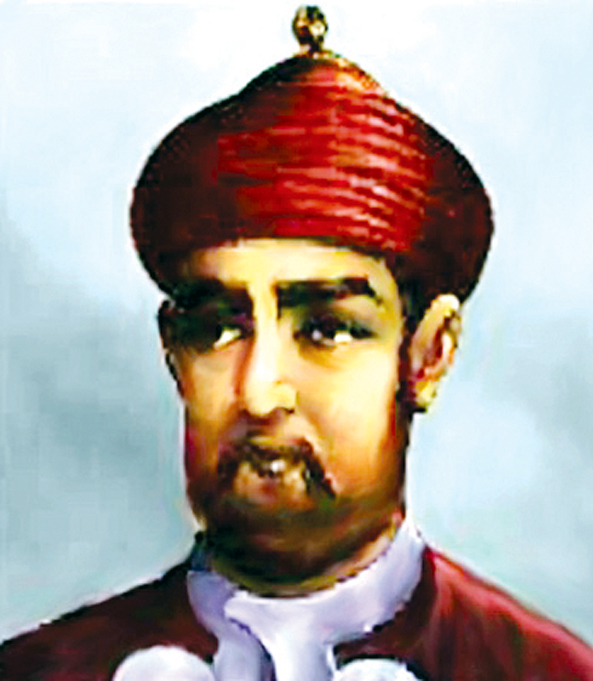
Muhammad Bin Tughlaq
A.D. 1330 - Rajanaka Prithvi Chandra, who resided in the fort of Kangra, was attacked by Muhammad Tughlak in the year A.D. 1337. In the Odes of Baelr-i-Chach (a poet at Muhammad court) we find the following: "when the sun was in Cancer, the king of the time (Muhammad Tughlak) took the stone fort of Nagarkot. It is placed between rivers like the pupil of an eye; the fortress has so preserved its honor and is so impregnable that neither Sikander nor Dara were able to take it, within are the masters of Katoch (named used for the kingdom Kangra then), within also are beauties resplendent as the sun. Its chiefs are all strong as buffaloes with necks like a rhinoceros. The exalted king of kings of the earth arrived at night under the fortress with his army of 1,00,000 strong, records from this point onwards do not mention the progress of the siege but we can assume that the siege was not successful because Prithvi Chandra handed the kingdom of Kangra and its forts to his son.
Rajanaka Parab Chandra A.D. 1341: He was succeeded by his son Rajanaka Roop Chandra in A.D. 1360 within five years of his accession, Roop Chandra had to defend his country against Feroz Shah Tughlak. Harassed by the new power in India, the Rajput princes took advantage of every opportunity they got to fight the Muhammadans. In keeping with the policy Rajanaka Roop Chandra of Kangra in the early part of his reign set out with his followers on a raiding expedition in the plains (his motive was only to collect loot not lands). He plundered villages and towns (of present day Punjab and Haryana), and had almost reached the gates of Delhi. On his return (laden with booty) Rajanaka Roop Chandra was confronted by Shahab-ud-Din, the Raja of Kashmir the battle raged between the two for a few days (near present day Nangal), to no result. On finding an opportune moment Rajanaka Roop Chandra with some of these followers and most of his booty escaped to one of his nearby forts of Naina Devi.
TARIKHI-i-FIROZE SHAHI refers to a siege headed by Feroz Shah in A.D. 1368 against Kangra, in revenge to Rajanaka Roop Chandra's incursions. Feroz Shah attacked the fort of Kangra for 6 months, but was unable to reduce it. Rajanaka Roop Chandra sent his Mehtas (counsels of peace) to the camp of Feroz Shah. A peace agreement was made and both the kings showered priceless gifts on each other. It is said that Feroz Shah visited the famous Brijeshwari temple of Kangra, where he presented to the temple an umbrella made of gold for Goddess. He also had a Hindu book from the temple library translated into Persian (DALAYIL-i-FIROZI SHAHI).
An interesting note is found in the MA'ASIR-ul-UMARA (referring to the same siege). One of the kings of Islam, Sultan Feroz Shah with all his armies attempted to reduce the fort of Kangra. So long was the siege that a conclusion was reached that the capture of the fort was impossible. So the Sultan contended himself with an interview with the Raja. They say that the Raja invited the Sultan into the fort. In the course of conversation the Sultan asked the Raja - "What would happen if I the Sultan captured you and seized the fort?" The Raja is said to have smiled and made a sign to his men, who at once crowd after crowd (armed to the teeth) came out of their hiding places. It was the Sultan who was now in shock, but the Raja assured him that this was a precautionary measure. Rajanaka Roop Chandra was succeeded by.
Rajanaka Sangara Chandra, in A.D. 1375 - Not many details are available of his reign, but one incident worthy of mention is that in A.D. 1387 Nasir-Ud-Din (the eldest son of Feroz Shah) was forced to abdicate in favor of his cousin. Nasir-Ud-Din in order to save his family and himself took refuge with Rajanaka Sangara Chandra of Kangra. In Kangra, he remained till A.D. 1390, when he was recalled to Delhi in the month of August to reclaim his throne under the new name of Muhammad Tughlak, for the generosity shown towards the Sultan by the Katoch King - the title of Miyan was given to the Katoch Royal Family, this title made the Rajas of Kangra equal in status to the Sultan and his family. (The tradition of eating grain grown only in the fields of Rajputs started from here).
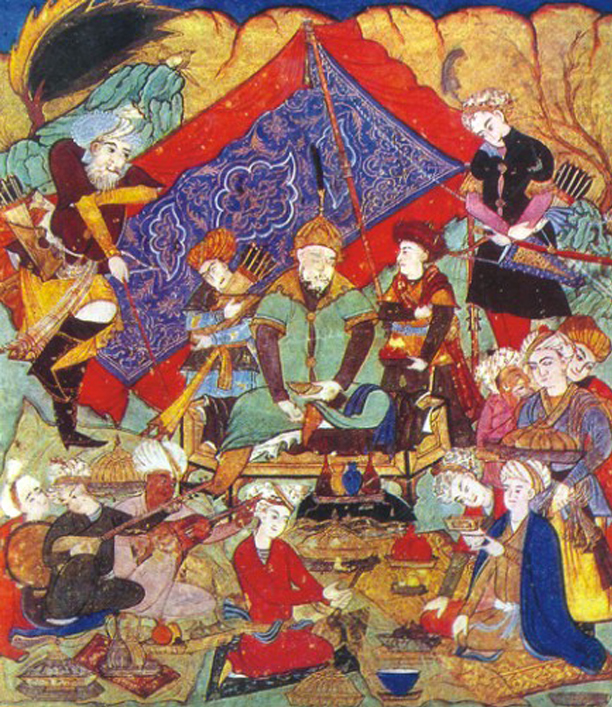
Taimur
In A.D. 1391 - Rajanaka Megh Chandra came to the throne of Kangra, he is credited with opposing the march of Taimur into the hills (Taimur invasion of India A.D. 1398-99, he was a descendent of Genghis Khan, which means king absolute). In the memories of Taimur "MALFUZAT-i-TAIMURI" the first paragraph refers to Kangra. "When I entered the valley on that side of the Shivaliks, information was brought to me about the town of Nagarkot, which is a large and important town of Hindustan. The distance was 30 kos (120 km) but the road lay through jungles and very lofty and rugged hills. The Raja of Nagarkot has a large number of retainers. As soon as I learnt of these facts about Nagarkot and the country around it, my whole heart was intent upon carrying the war against the infidel Hindus. There is further mention of the battle of Nagarkot in MALFUZAT-i-TAIMURI but we will stay with the facts which are that the Raja of Kangra lost eight of his important forts (including the fort of Nurpur), but Taimur was never able to reach Kangra.
In A.D. 1405 - Rajanaka Hari Chandra succeeded to the throne of Kangra. A few years into his rule, an incident occurred which further divided the kingdom into two parts. - "while out on hunting Rajanaka Hari Chandra fell into a well from which he could not come out (without help). For days his officers and men searched the area but did not succeeded in finding him. While in Kangra (as the throne could not be left empty) his younger brother Karam Chandra (A.D. 1416) performed the last rights of his brother (it is believed that Rajanaka Hari Chandra wives committed Sati). Raja Karam Chandra now sat on the throne of Kangra. After 22 days a merchant passing through the forest discovered Raja Hari Chandra. On hearing of what had happened in Kangra, Raja Hari Chandra decided not to go back to Kangra. Instead he met his brother on the banks of river Beas, where it was decided that Rajanaka Hari Chandra would establish another state and the site chosen for state was Haripur Guler (380 sq. miles). Raja Hari Chandra built the fort of Haripur (which still exists) Raja Karam Chandra of Kangra also presented his brother with two forts adjoining his new territories Kotla and Trilokpur (existing to this day). Three interesting stories are also related to this incident:
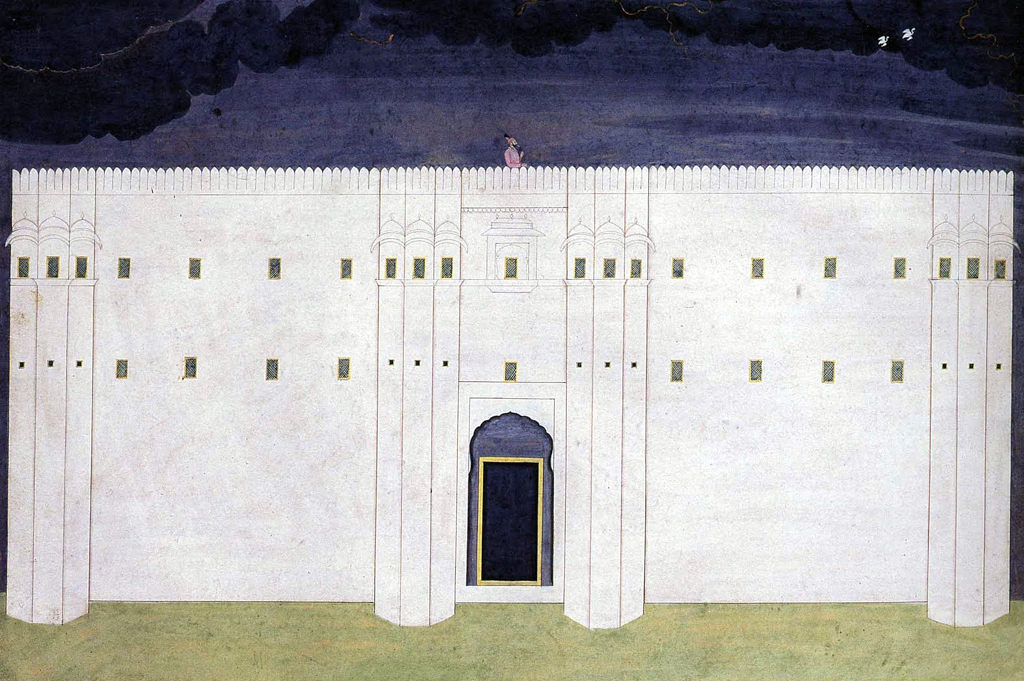
Guler Fort
- The surname Katoch got its second meaning, "as Hari Chandra was the elder brother and the State of Kangra was the parent state - so the question arose of precedence (over one another) - to solve the dispute Raja Hari Chandra gave presidency to kangra over Guler by Saying "Katey Per Oonchey ie - Katoch). Raja Hari Chandra also changed his surname to Guleria. The state of Guler was further divided in history - Dada Siba (founded by Raja Sibran Chandra) and Datarpur State.
- Hari Chandra also as a mark of superior investiture anointed the forehead of Raja Karam Chandra by his own blood and pearls. He also proclaimed Rajanaka Karam Chandra as Bada Raja "meaning bigger king - this title was later converted by the Mughals to Maharaja.
- The merchant who rescued the Raja Hari Chandra was exempted of taxes on his goods (as a hereditary honor), this right was respected by all Rajas until the British annexation of Kangra.
A.D. 1429 - Bada Rajanaka Sansar Chandra-I, inherited a peaceful empire from his father. Records existing at the Brijeshwari temple in Kangra suggests that he was is alliance with Mohammad Shah Saryid of Delhi (A.D. 1435-44).
A.D. 1450 - Bada Rajanaka Devangga Chandra came to the throne; he too likes his father enjoyed peace in his kingdom.
A.D. 1463 Bada Rajanaka Narinder Chandra came to the throne, he died in A.D. 1480 and left the state in confusion as both his Ranis were pregnant (the first born son would be king). Fearing for her safety the younger Rani left Kangra for her fathers home (Raja of Puna). While on her way (still in the boundaries of Kangra) she gave birth to Suvira Chandra (in a peasants hut). While at Kangra the elder Rani gave birth to a dead child. On seeing a vacuum of power she took control of the kingdom of Kangra (the first and only Rani ruler of Kangra).
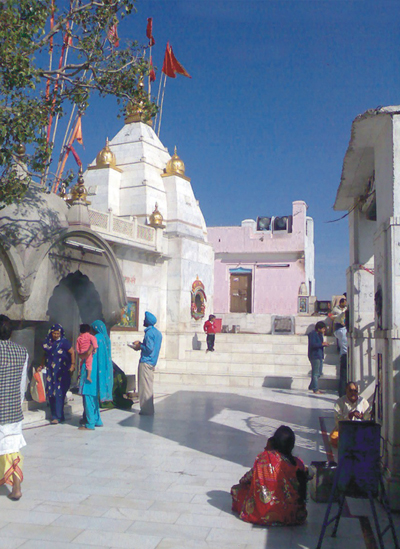
Naina Devi Temple
Suvira Chandra returned to Kangra at the head of an army supplied to him by his maternal-grand-father. By stratagem he captured the fort and was installed as the rightful Bada Rajanaka (the peasant's who's house he was born in was given a jagir existed till the days of the British Raj).
Bada Rajanaka Prayag Chandra followed his father in A.D. 1499 and after him his son Bada Rajanaka Ram Chandra followed in A.D. 1520, he died (childless) in A.D. 1538 and was followed by. Bada Rajanaka Dharam Chandra (younger brother of Devangga Chandra). In A.D. 1540 after the expulsion of Humayun from India Sher Shah Suri gained control and he sent his able General Khawas Khan to Nagarkot in order to gain submission of the hills. "WAQIAT-i-MUSHTAKI" refers that after subduing the hills and gaining favorable treaties from the Raja of Nagarkot Khawasa Khan plundered the Devi Shankar temple and brought back to his Sultan a stone which had been worshiped in the temple for over two thousand years and also its umbrella made of copper. The Sultan then ordered the stone to be made into weights to measure cow's meat and the umbrella was melted and made into pots which were placed in the palace mosque to wash the hands and feet of the faithful before prayer (Hadim Khan Kakar was made Governor of the hills). Sikander Shah Suri fled to Nurpur (now under the control of Kangra kingdom) and took refuge. In February A.D. 1556 Akbar was installed as the Emperor of India. In the following year Akbar had to face an insurgence from Sikander Shah who had invaded Punjab with help of the Katoch Raja of Kangra.
Bada Rajanaka Dharam Chandra was not present in the battle as he was an old man of 90 years. Sikander Shah was once again defeated by Emperor Akbar and his General Behram Khan chased Sikander Shah to Moukot (a strong hold of the Katochs) which lay half way between Pathankot and Nurpur. The fort was besieged for nearly eight months. Sikander Shah now faced starvation and his soldiers were hard pressed. It was under these conditions that Sikander Shah surrendered to Akbar.
Akbar met him favorably and granted his a jagir in Bihar and Kharid. Sikander Shah Suri died in A.D. 1559. The emperor now turned his attention towards the Raja of Kangra (according to Akbar the most renowned of all the Rajas of the hills). It is recorded that no battle was fought between the Raja and the Emperor, instead they met at Nurpur and exchanged expensive gifts. The Raja of Kangra rendered his alliance to the Emperor and sent one of his sons as a friendly hostage to the court of Akbar. In exchange the Emperor Akbar granted the title of Maharaja (in consideration of his ancient status and age) to the Rajas of Kangra (probably the first in India to get a title from the Mughal) (there is also a play written on the life of Maharaja Dharam Chandra called "Dharam Chandra Natak" written in A.D. 1562).
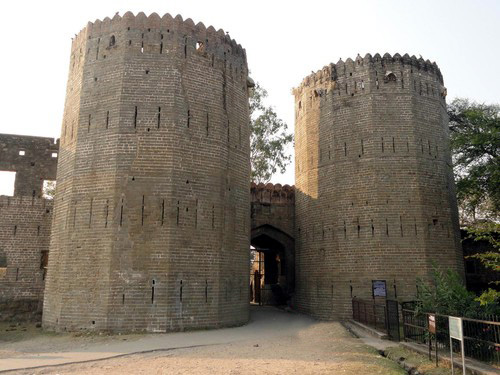
Nurpur Fort
A.D. 1563 Maharaja Manakay Chandra came to the throne and after him in A.D. 1570 Maharaja Jai Chandra-I is said to have established his own haveli in Delhi and Agra. For some reasons Maharaja Jai Chandra fell into the bad books of the Emperor. The Emperor placed him under house arrest in Delhi. Presuming his father to be dead Maharaja Jai Chandra's son, Bidhi Chandra took control of the kingdom. In A.D. 1572 Emperor Akbar ordered Khan Jahan Hussain (better known as Hussain Quli Khan) and the Raja of Guler to annex the kingdom of Kangra and place it in the hands of Raja Birbal (one of Akbar's nine important courtiers). The Mughals forces advanced to Nurpur where Bakht-Mal, a relative of Bidhi Chandra, surrendered the fort of Nurpur to the Mughals (in return of this favor, Bakht-Mal was made the first Raja of Nurpur thus a further division of the State of Kangra Nurpur State was spread over an area of 180 sq. miles and included the three main forts of Pathankot, Maukot and Nurpur). The Mughal army then advanced to the fort of Kotla (originally gifted by Kangra to Guler) which was held by the Kangra forces. A fierce battle took place which lasted for almost one week. An unlucky moment for the Kangra forces decided the fate of the battle the granary had caught fire and all the suppliers within the fort were lost, under these circumstances it was impossible to hold the fort, so by the cover of night the Kangra forces re-treated to the fort of Kangra. The next morning the fort of Kotla was handed over to the Raja of Guler. The Mughal Army now marched towards the fort of Kangra & on their way they destroyed the fort of Trilokpur. Within two days on 8th November A.D. 1572, the fort of Kangra was besieged. The campaign was progressing favorably for the Mughals, but a turn of faith saved the fort and its rulers "Ibrahim Hussain Mirza and Masud Mirza (relatives of Akbar) had invaded the Punjab plains. Khan Jahan had to be called back from Kangra to deal with the situation in Punjab", (thus, the ambitions of Raja Birbal to become the master of Kangra remained unfulfilled). These records have been taken from the "TABAKAT-i-AKBARI". Further records of this incident can be found in the accounts of Masir-i-Umara and the Akbarnama, the latter suggests that Maharaja Jai Chandra and his son Bidhi Chandra tried to make amends with the Mughal court They were made to give as tribute to Raja Birbal (for renouncing his right on Kangra in the favor of the Katoch kings) five maans of Gold (Akbarshahi weight 200kgs.). In February of A.D. 1573 the siege was raised and the Katochs were left in peace temporarily.
In A.D. 1578 Emperor Akbar deputed Todar Mal for yet another expedition against Kangra On returning from his expedition Todar Mal informed his Emperor that "he had taken the meat and left the bone", meaning that he had annexed the fertile lands of Kangra and left only the forested hills for the Maharajas. Todar Mal also informed the Emperor that Kangra was famous for five things
- Cutting of tongues and offering to the Goddess, which grow back within a few hours.
- Of the replacement by operation of amputated noses and body parts.
- The treatment of eye diseases.
- The basmati rice grown in the valley.
- The strong fort of Kangra.
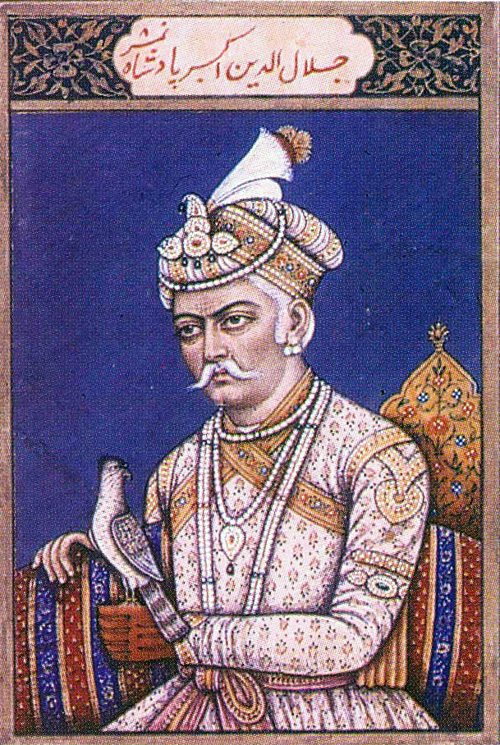
Emperor Akbar
On hearing of these facts the Emperor was keen to see Kangra for himself. Emperor Akbar could only reach as far as the Jwala Mukhi temple (where he presented the temple with the gold roof).
He turned back from Jwala Mukhi on the 23rd of March A.D. 1582. His turning back also marked the termination of the 10 years siege of Kangra. Maharaja Jai Chandra retained his throne. (It is believe that in the early days of the siege, Emperor Akbar had planted a garden called Ram bagh, from which on the day the siege ended he ate the first fruit (a mango) from the tree planted by him). Maharaja Jai Chandra died in A.D. 1585 and was succeeded by his son Maharaja Bidhi Chandra. He coaxed all the small hills chieftains (A.D. 1588-89) of Mankot, Jammu, Jaswan, Jasrot, Basoli, Bilaspur and Lakhanpur to break out in rebellion against the Mughal Court. These hills rulers under the leadership of Bidhi Chandra amassed a large army consisting of ten thousand horsemen and one lac foot soldiers. The Ain-I-Akbari narrates the following That in the 35th years of Akbar reign the hills of Hindustan broke into rebellion. Zain Khan (Akbar's foster-brother) was sent to sub-due the rebellion. He entered the hills at Pathankot, thus dividing the enemy into two parts. A battle raged in the plains of Pathankot, the combined armies of the hill Rajas was no match to the imperial army of the Mughals. All the Rajas were restored to their rightful kingdoms after their submission. Maharaja Bidhi Chandra was made to send his son Trilok Chandra as a hostage to the Mughal Court. An interesting story is narrated by the people of Kangra "Prince Salim (Jahangir) and Trilok Chandra (both of the same age) as boys were together in Delhi Trilok Chandra had a talking parrot which Jahangir wanted to acquire but Trilok Chandra the young Rajput Prince refused to give the parrot and instead sent a trained hawk to Jahangir for his pleasure. On this account, it is said that Jahangir cherished a grudge against Trilok Chandra and marched against Kangra on becoming Emperor.
In A.D. 1607 Trilok Chandra becomes Maharaja, and in just a few years he revived the use of local coinage under his own name (this system of money had been abolished from the time, when Akbar become the Emperor). Jahangir who had become the Emperor of India (A.D. 1605) found the perfect excuse to exercise his old grudge against Kangra. Jahangir commanded Sheikh Farid and Murtaza Khan, the Governor of Punjab to invade Kangra A.D. 1615.
"TARIKH-i-PUNJAB narrates the following: All the hill rajas were summoned by Jahangir to his court in Delhi. Before leaving Kangra Trilok Chandra had made adequate arrangements for the defense of his country. He had placed his prestigious fort (Kangra) under the command of his uncle (mother's brother) the Raja of Chamba.
In Delhi all the hill rulers including Trilok Chandra were showered with gifts but Jahangir had secretly ordered the arrest of Trilok Chandra. Maharaja Trilok Chandra had heard of this plan and fled from his haveli in Delhi. When Jahangir heard of this he sent his troops after Trilok Chandra, the Mughal troops caught up with him in Kirtipur (20 km. from Anandpur and 70 km. from his nearest fort at Amb) in Punjab, where while defending himself he was killed, (Jahangir confiscated Maharaja Trilok Chandra havelis of Delhi and Agra).
In January A.D. 1615 The 12 years old Hari Chandra-II came to the throne, and on 2nd April, A.D. 1615 as stated in the memories of Jahangir Tazuk-i-Jahangiri "Murtaza obtained my permission to leave for the expedition against the fort of Kangra along with him, I sent Raja Suraj Mal of Nurpur, and I also release Raja Man (of Amber, Jaipur) from his confinement at the fort of Gwalior to accompany Murtaza Khan on this expedition."
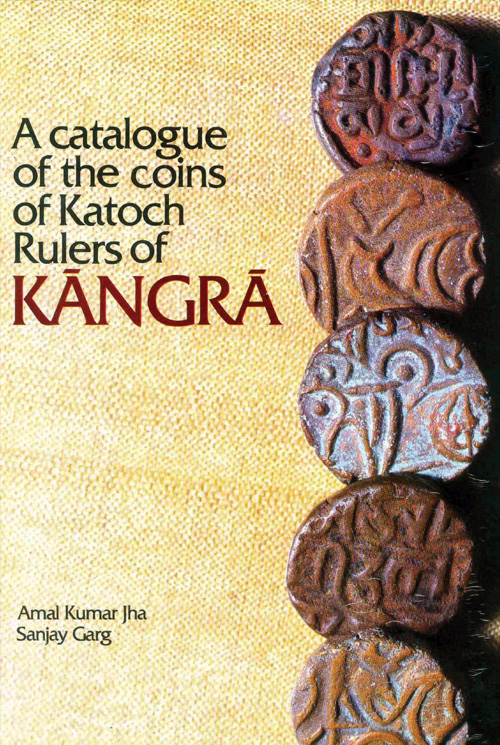
Coins of Kangra
For one year the fort was besieged and it was then, that Raja Suraj Mal of Nurpur presumed that the fort would surrender, so he started control rebellion within the Mughal ranks, (this act of loyalty towards the Katochs is still respected). Murtaza Khan sent Raja Suraj Mal back to Delhi where he was attacked to Jahangirs personal army. On the 20th of October, A.D. 1616 Murtaza Khan died in Pathankot and the siege was raised. Raja Man was now appointed the Governor of Punjab by the recommendation of I'timad-Ud-Daulah. It was now on Raja Man's shoulders that fall the task of conquering the fort of Kangra.
Raja Man Singh left Delhi for Lahore to mobilize his troops. Just a few days before he was to march on Kangra he got news that Raja Sangram of Jammu with the help of Maharaja Hari Chandra II forces had occupied the district of Hoshiarpur (in Punjab). Considering this to be important, Raja Man Singh advanced with his army, towards Hoshiarpur. Man Singh's army comprised of Muslims and Rajputs from the Rajputana (they were not used to fighting in the hilly terrain).
On seeing the advancing army Raja Sangram Singh retreated to the familiar grounds of the difficult hill country. Man Singh considered this to be a weakness of his enemy and pursued Sangram Singh into the hills without taking care of his path of retreat. A fight took place (near Natri-Kotla) and the Mughal forces were completely routed. Raja Man Singh lost his life in this battle and the siege of Kangra was deferred once again. Maharaja Hari Chandra erected a cenotaph for Raja man Singh (head of the Kachawa clan of Rajputs) on the very spot on which he fell as a sign of respect for another Rajput ruler. Once again on September 12th A.D. 1617 on the recommendation of Khurram (Shahjahan) Raja Suraj Mal and Shah Quli Khan Mohammad Taqi were sent to Kangra to subdue the fort. Raja Suraj Mal had earlier helped the Katochs and this time too his only intention was to return to his home. On reaching the fort Suraj Mal sent a letter to Shahjahan (who was in charged of this expedition), suggesting that Quli Khan was incompetent and was responsible for the slow progress. The Mughal court recalled Quli Khan and left Suraj Mal in-charge of the expedition. Suraj Mal took advantage of his position and dispersed the imperial contingents to their respective jagirs for re-equipping themselves. Having in this way weakened the Mughal army he started to raise disturbances and his own troops ravaged the Mughal camp and carried off to their fort in Nurpur whatever they could lay their hands on. So once again the Mughal attempt to take the fort was unsuccessful.
Jahangir was in Ahmedabad where he got news of this revolt, he immediately dispatched one of his commanders Sundar Dass (Rai Raiyan) to suppress the revolt. Rai Raiyan was helped by Jagat Singh, the younger brother of Suraj Mal. Raja Suraj Mal was defeated and Jagat Singh was made Raja of Nurpur (Raja Suraj Mal died in Chamba in A.D. 1619).
On 5th September, A.D. 1619, the siege of the Kangra Fort was resumed by Rai Raiyan and Raja Jagat Singh. On October 14th A.D. 1619, the Mughal army reached the city walls of Kangra and on their way to Kangra they successfully defeated and occupied the Katoch forts of Mara, Thari, Nesa Sur, Jawali, Kotla and Trilok Pur.
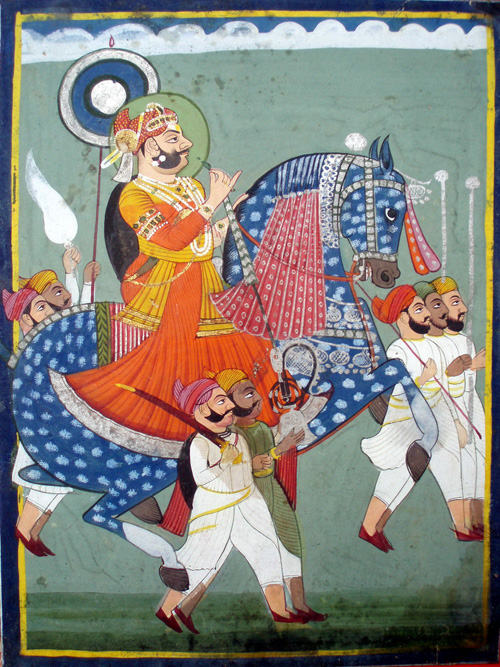
Raja Man Singh
The siege on Kangra fort lasted for one year and two months. The garrison within the fort was reduced to such extremes, that in the absence of a grain they stripped the bark from trees mixed with grass and salt and boiled it as food. Under such extremes conditions, the Maharaja of Kangra was forced to make a treaty with the Mughals. (25th December, A.D. 1620).
Jahangir under the influence of Ala Hazrat (Shahjahan) pardoned Maharaja Hari Chandra on the condition that the fort of Kangra be handed over to the Mughal garrison and that Maharaja Hari Chandra should attend the Mughal court in Delhi.
This was the first time in the history of Kangra that its prestigious fort was garrisoned by and enemy force.
"WAQIAT-i-JAHANGIRI states that on hearing of this conquest Jahangir himself bowed in front of the throne of Allah and thanked him for this gift. He also insured that the following statement was noted in "FATEH-i-KANGRA "the said fort has never passed to any tribe or stranger and certainly from the time when the voice of Islam sounded not one of the Sultans had gained victory over it, even Sultan Feroz Shah with all his might did not succeed. Who ever sat on the throne of Delhi sent an army to subdue Kangra but they never succeeded, not even my father (the great Emperor Akbar)."
The following extract is from "SHASH FATEH-i-KANGRA" written in the time of Shahjahan (he was in-charge of this expedition and was based at Nurpur at the time of siege) "The Royal soldiers breeched the walls and shot down a great number of their opponents. The whole atmosphere was filled with the smoke of guns, and the arrows of our archers made so many holes in the shields of the Rajputs that they resembled beehives. Although, the Rajput had fought with great vigor and courage they were entirely defeated (almost 12000 Katochs Rajputs fell to martyrdom defending their king and country). In the joy of this victory the Emperor distributed the entire wealth captured from the fort to the poor and his courageous warriors (this wealth had been re-accumulated within the fort after A.D. 1009).
Thus the famous fort passed from the possession of the Katoch prices. A strong garrison was placed in the fort and the whole country of Kangra was annexed; only the district of Rajgir, Lambagraon (worth one lac rupees) was assigned as a Jagir for the maintenance of the Royal Katoch family. Maharaja Hari Chandra now re-conciled himself in his fort at Bijapur.
In January, A.D. 1622 Jahangir visited Kangra. So fascinated he was by the beauty of Kangra that he ordered a palace to be build in Gargain (it was never completed and the foundations still exist).
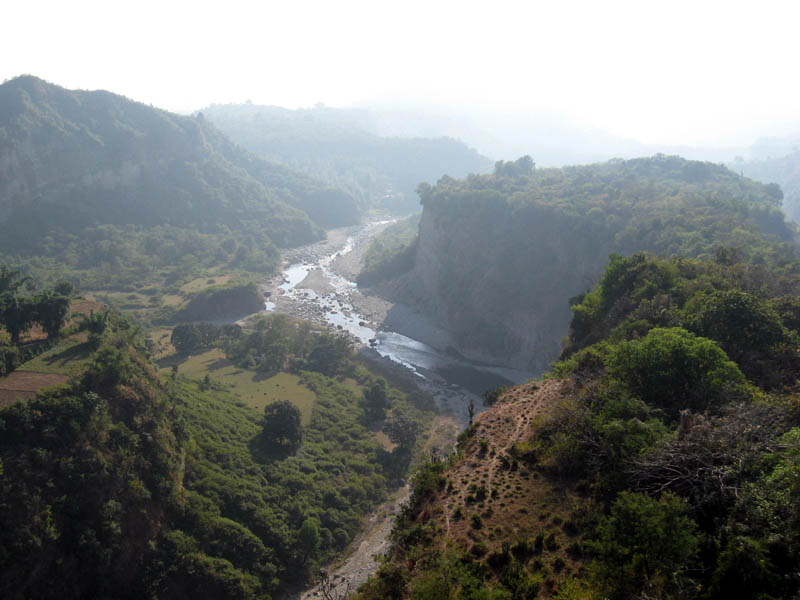
View of Banganga from Kangra Fort
The Emperors own pen records (WAQIAT-i-JAHANGIRI) As I had a great desire for the air of Kangra. I left my great camp (at Siba) and proceeded towards the famous fortress. After a 4 days march I reached the river Ban Ganga which flows below the fort. On my arrival at the fort, things were done such as had never been done before in the history of this fort. I had a cow cut and offered thanks to the almighty for this grandest of grand conquest. I ordered a large mosque to be built in the fort (it still stands). I also ordered a gate to be built in my name (the Jahangiri Darwaza, the marble inscription of the gate is now in the Museum at Lahore).
Maharaja Hari Chandra did not stay quite for long and in about A.D. 1627, he started conducting guerilla warfare against the Mughals. In the same year, he was captured and flayed alive on the walls of the fort of Kangra.
(Earlier in the reign of Maharaja Hari Chandra and his father's they were visited by the first European travelers to this region).
William Finch in 1611, Sir Thomas Roe and Sir Thomas Coryat 1617 They have mentioned in their records, eye witness accounts of the famous Durga temple and have also mentioned the independent and powerful Katoch Raja "This Raja is Powerful and his a mountain situation secure, and not once has been vanquished by any enemy." They also witness the cutting of tongues as offerings to the Goddess.
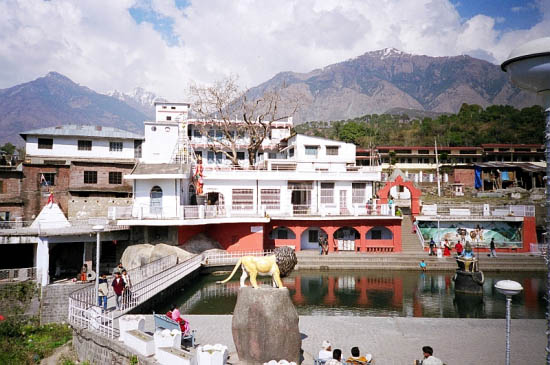
Chamunda Devi Temple, Kangra
A.D. 1627 Chander Bhan Chandra "who still lives in the memory of the people of Kangra for his brave and spirited resistance against the Mughals". He built the "Chander Bhan ka Qila" (the fort of Chander Bhan) at a height of 9,000 feet, from here he conducted his campaign of plunder against the Mughals (this fort also contains the original Chamunda Devi Temple). An army was sent from Delhi to capture him, and at length they pursued him. He was finally captured and imprisoned in Delhi, where he died in A.D. 1658 (details from Tarikh-I-Punjab). Maharaja Vijay Ram Chandra A.D. 1658 succeeded his father and according to Tarikh-i-Punjab was summoned by the Emperor to Agra. There he made favorable terms with the Mughals court and was granted the taluquas of Nadaun, Palm, Mahal Sarai, Jai Sukh and Malhar, in addition to his Jagir of Rajgir. He was also given Mansabdari of five thousand soldiers. Now with his new status and the revenue (five lacs rupees) he started a program of construction. He re-fortified the fort at Bijapur and erected within it a palace in white plaster (of sea shells). He then built a wall around the adjoining villages of Jaisinghpur and also constructed a fortified wall which stretched for 27 km. on the borders of his kingdom and Mandi State. (Portion of this wall are still standing).
A.D. 1687 Maharaja Uday Chandra the younger brother of Vijay Ram Chandra succeeded to this throne. His reign saw peace and prosperity and the Katoch Rajputs had quietly settled down as tributaries of the Mughals.
A.D. 1691 Maharaja Bhim Chandra ascended to the throne. He was a contemporary to Emperor Aurangzeb.
Aurangzeb's intolerance towards the Hindus and his act of breaking old temples to give way for Mosques turned Maharaja Bhim Chandra into a rebel. He joined Guru Gobind Singh Ji The two of them successfully routed Mian Khan and the Raja of Jammu who had been sent by Aurangzeb to crush the rebellion in Punjab. Maharaja Bhim Chandra is still remembered in Sikh Songs. In return of his alliance with Guru Govind Singh Ji The Guru gave him a hereditary title of Dharam Rakshak (Defender of the Hindu faith).
(Maharaja Bhim Chandra's younger brother Kirpal Chandra built the Kirpal Kul a water course from the snow fed streams to the districts below of Bhawrana. This was the largest water course in India (when built) and is still used by people for irrigation).
A.D. 1697 Maharaja Alam Chandra succeeded his father; he founded the town and palaces of Alampur.
A.D. 1700 Maharaja Hamir Chandra came to the throne. He had a long reign and is also credited with building the fort and town of Hamirpur, (now a district). He also saw the appointment of Saif Ali Khan (A.D. 1740) as the last Mughal Governor of Kangra. A.D. 1747 Maharaja Abhay Chandra came to the throne (he was in his mid life). He is credited with building the Thakur Dwara (Laxmi-Narayan) temple, in Alampur and also the fort of Riyahi. Abhay Manpur, Mangarh and the fortification at Tira (Tira Sujanpur).
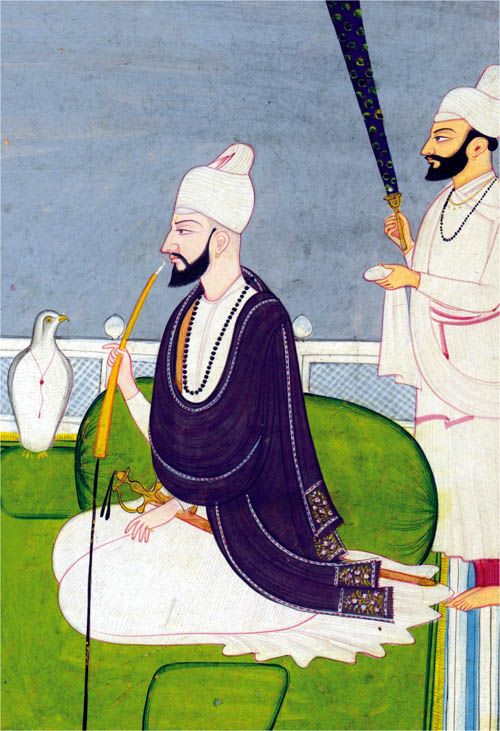
Raja Ghamand Chandra
A.D. 1750: Maharaja Ghambhir Chandra who was Maharaja Abhay Chandra's uncle (younger brother of Maharaja Hamir Chandra), sat on the Gaddi (throne) for one year and when he died he left 11 sons who were not liked by the people and the officials. Ghamand Chandra was the son of Maharaja Ghambhir Chandra's younger brother. He was a ruthless man, (like Genghis Khan he too was born with a blood mark on his palm). He avenged the death of Maharaja Hari Chandra (A.D. 1627) by flaying a contingent of the Mughal forces that he had captured. Ghamand Chandra on the day of his uncle's funeral in A.D. 1751 captured all his 11 cousins and sealed them in a cave to die (in the jungles of Nadaun). Thus, Maharaja Ghamand Chandra took power. He had a burning ambition to reclaim the lost glory of Katoch Kings. The Mughal Empire was on its decline, with Ahmed Shah Durrani and the Marathas struggling to gain control of India, Maharaja Ghamand Chandra found the opportunity to flex his muscles. "Taking advantage of the anarchy prevailing Maharaja Ghamand Chandra managed to recover all his territories which were under the Mughal command (except the fort of Kangra). In A.D. 1758 Maharaja Ghamand Chandra rendered his alliance to Ahmed Shah Durrani who had become master of all Punjab. As a return of favor Ahmed Shah made Maharaja Ghamand Chandra the Governor of Jalandhar Doab (the area that had been lost to the Muslim's approx. 700 years ago) and the title of Nizam-i-Jalandhar was conferred upon him as a hereditary distinction (the only Hindu Rajput Nizam in India), with this Maharaja Ghamand Chandra acquired supremacy over all the other hill states. He annexed half of the Kutlehar states, he seized the fertile land of Chamba conquered Kullu (Leh and Ladakh). The small principalities with within the old kingdom of Kangra (Nurpur, Mau, Guler, Datarpur, Siba, Kotla, Trilokpur, Una, Amb) were subdued. He strengthened the fort of Pathiyar (near Palampur). He acquired a large army of Afghan mercenaries and repeatedly attached the fort of Kangra, but all his attempts to take the fort were unsuccessful. Maharaja Ghamand Chandra ruled over an estimated area of 19,000 sq. miles and his revenue exceeded 11 lac Rupees. With the ancient limits of his state restored (Not Multan) he started the construction of the walled town of Sujanpur, and beautified the palaces in Tira (Tira Sujanpur). He is credited with establishing many fine office buildings and also the Kangra Haveli in Lahore.
A.D. 1774 Maharaja Tegh Chandra came to the throne; he only ruled for one year and maintained a very large army.
A.D. 1775 Maharaja Sansar Chandra only a minor then started his glorious rule over Kangra. His reign was the contemporary golden age of the Katoch's of Kangra. To start with Maharaja Sansar Chandra's main aim was to capture the Kangra Fort (still being held by the aged Saif Ali Khan on behalf of the Mughals). In A.D. 1781-82 Maharaja Sansar Chandra at the age of 16 invited Jai Singh Kanheya to invade the fort of Kangra. In A.D. 1783 by stratagem the fort fell in the hands of Jai Singh, the Sikh leader. This account has been recorded by Mr. Forster who traveled through Kangra in A.D. 1783. Jai Singh had bribed one of the sons of Saif Ali Khan and on the death of Saif Ali Khan, in lieu to safe passage the sons of Saif Ali Khan handed the fort to Jai Singh, who immediately took charge of the fort. After this betrayal Maharaja Sansar Chandra turned on his friend and solicited the help of Maha Singh Sukerchakia, Jessa Singh Ramgarhia (sworn enemies of Jai Singh) and besieged the fort again. This time the siege lasted for four years. Maharaja Sansar Chandra had confiscated Jai Singh's territories in the plain and had also killed Jai Singh's son in Batala. Jai Singh was now alone and out of resources, the conditions within the fort were intolerable. He now compromised with Maharaja Sansar Chandra and in lieu of the surrender of Kangra fort to Maharaja Sansar Chandra; Jai Singh was returned some of his territories in the plain of Punjab. Now with the possession of his ancient family fortress and wielding supreme power in the hills Maharaja Sansar Chandra once again proved the proverb. "He who holds the fort rules the hills" true. He now turned his ambitions of acquiring a great kingdom in the plains. The salutation in his court "Lahore Prapt" (May you get Lahore) aptly shows the extent of his ambitions.
- The Raja of Chamba was killed in a battle against Maharaja Sansar Chandra and the whole of the Chamba was annexed (except Bharmour which was left for the Chamba ruling family).
- The state of Mandi was sacked and plundered. Maharaja Sansar Chandra entered triumphantly into the capital, town of Mandi wearing armor made completely of gold. The Raja of Mandi was taken prisoner and held at the Chaumukhi fort of Nadaun for 12 years.
- The Raja of Suket did not oppose Maharaja Sansar Chandra and rendered complete alliance to the kingdom of Kangra.
- The Raja of Kullu was allowed to continue the same treaty which his ancestors had signed with Maharaja Ghamand Chandra (They were allowed to rule their kingdom on the basis of yearly revenue).
- Lahoul & Spiti (an area of almost 7000 sq. miles) was allowed to be ruled by their petty chieftains under the same treaty of yearly revenue.
- The State of Kutlehar was completely annexed and the Raja completely disposed. Maharja Sansar Chandra dismantled the original fort of Kutlehar and constructed in its place 16 different forts called the Solha Singhi (the 16 tiger fortresses). These guarded his south-western frontier.
- The state of Arki (Shimla hills) rendered his alliance to Maharaja Sansar Chandra.
- The Raja of Nahan was defeated and killed. There is an interesting story about why this battle was fought "It is said that the Rani of Nahan was Maharaja Sansar Chandra's Sister & she commented to her husband that her brother had in his service more syices (horse groomers) than the entire army of Nahan.
- The Raja of Nahan took offence and declared war on Kangra. The two armies met on the Southern border of the Bilaspur State The Kangra army out numbered the Nahan army by 70 to 1. On seeing such impossible odds, the Raja of Nahan challenged Maharaja Sansar Chandra to a personal combat in which the Raja of Nahan lost his life. It is said that Nahan army fell at Maharaja Sansar Chandra's feet. Maharaja Sansar Chandra forgave the army and marched towards the capital of Nahan (Sirmour) & on reaching the border of Nahan he was informed that his sister was expecting a child. Maharaja Sansar Chandra then proclaimed that if his sister gave birth to a son, her son would be made Raja. Three months later his sister gave birth to a son, who was declared Raja, thus, the state of Nahan was saved from complete annexation by Maharaja Sansar Chandra (Nahan remained independent but were made to pay annual revenue).
- Maharaja Sansar Chandra gained a tremendous renown which had not been surpassed by any of the other hill rulers. For 20 years no one dared to resist his will. An example of this can be seen by the following The great Darbar Hall which he build in Tira Sujanpur has 22 gates (eleven on each side) representing every ruler subdued by him. Each ruler was assigned an individual door from which they had to enter by first bowing at the door, and then they had to bow in front of the throne of Maharaja Sansar Chandra (the throne of Kangra was made of solid gold) which was placed at the head of the hall. All the rulers were obliged (eleven on the East and eleven on the West of river Ravi) to attend his court once a year. (From the balcony of this Darbar Hall which faced the chaugan - Maharaja Sansar Chandra on the day of holi threw saffron color in the air to start the festivities of Holi nagara beaters (drummers) were placed all around Sujanpur, they would then beat the drums to inform other villages that Holi had commenced these villages also had their own drum beaters who informed their adjoining village this ways of passing information from one town the other was used to send information to the far corners of the kingdom (this is how Holi was played).
- Next to come into the folds of Kangra was the state of Bilaspur - Maharaja Sansar Chandra annexed half of the State (area on the right side of Sutlej). There he built a massive fort to guard his frontier.
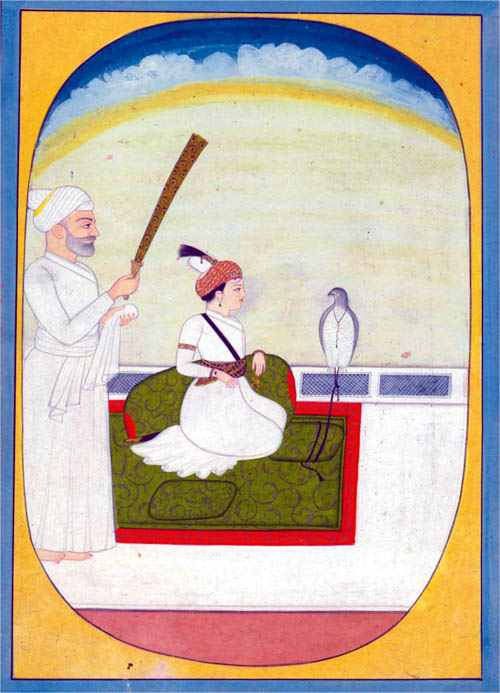
Young Maharaja Sansar Chandra
Maharaja Sansar Chandra being attended to by Colonel O' Brian
In this golden age of Kangra, Maharaja Sansar Chandra took the title of Chattrapati Naresh. He also constructed a temple within the fort of Tira Sujanpur This temple contains the largest Ashath Dhatu Idols (Shiv, Parvati, Nandi) in India. His name spread far and wide and people from all walks of life (soldiers, artisans, artists, craftsmen, dancers, musicians, carpet makers, jewelers, sword makers, cannon makers etc.) started to flock into his court. He was so revered by his subjects that they used to call him the Pahari Badshah (the Emperor of the Mountains). He greatly beautified the city of Kangra and Sujanpur. He built his Zanana Mahal (palace for his queens) in the gardens of Alampur (these gardens are said to have rivaled the Shalimar garden of Lahore). He built the fortified town of Nadaun (Chaumukhi fort) and embellished it with great palaces and other official buildings. This town is said to have been designed by the architects who was the same architects the Emperor Aurangzeb had used in the modifications of the Red Fort in Delhi (after the architect had completed the building of his town, Maharaja Sansar Chandra cut his hands and gave him and his family a Jagir in Mukerian (Punjab) where his descendants still live. In Nadaun, Maharaja Sansar Chandra brought and settled two hundred dancing girls, and such a city of pleasure was Nadaun that it had a popular saying "AAYEGA NADAUN JAEGA KAUN". (He who comes to Nadaun will never leave).
In the latter half of Maharaja Sansar Chandra's life he too was captured by the beauty of one of his dancing girl (Jamalo) with whom he spent the last days of his life. Maharaja Sansar Chandra was now the master of almost 27000 sq. miles of the Indian subcontinent and his yearly revenue exceeded 35 lac rupees. With so much wealth at his disposal Maharaja Sansar Chandra like the great Emperor Akbar established the system of "Chhattis Kaarkhanas" (36 factories which produced various handicrafts). The most famous of these crafts was the Kangra School of Miniature paintings and under patronage of Maharaja Sansar Chandra, almost 40,000 paintings were produced which depicted various Hindu epics and the court life of Maharaja Sansar Chandra.
Maharaja Sansar Chandra, with all his vast resources and the large army that he controlled, started dreaming of regaining the far reaching domains of his ancestors. In A.D. 1803-04 he invaded Bajwarah (Punjab) and occupied it (to commemorate his victory he build a palace with 7 large turrets two of which are still standing.
This was the period in history when two other powers of equivalent might and resources were on the rise.
- The Gorkhas under the command of Amar Singh Thapa were dreaming of creating a large mountain kingdom (which would stretch from Nepal to Kashmir). They had already acquired Garhwal, Sirmour, and the other small hill states of Shimla.
- Maharaja Ranjit Singh had already united all the Sikh Missiles under his banner and had become the lord of Punjab with his head quarters at Lahore. (It is said that the only ruler Maharaja Ranjit Singh feared was Maharaja Sansar Chandra for example he never dared to invade Kangra). Any merchant whose goods were not bought by Maharaja Ranjit Singh because they were too expensive would be purchased immediately by Maharaja Sansar Chandra in order to show his superiority. An envoy of Maharaja Sansar Chandra visited the court of Ranjit Singh & before bowing to the lion of Punjab, he removed his turban and then paid homage, when asked why he removed his turban before bowing, he replied that turban was given to him by Maharaja Sansar Chandra, thus it could not bow in-front of anybody.
The Gorkhas invaded Kangra and were severally defeated. They were forced to sign a treaty which marked the Sutlej River as their final frontier, never to be crossed again.
Maharaja Sansar Chandra under the advice of Nawab Gulam Muhammad (the disposed Chief of Rampur who was defeated by the British and had taken refuge at Tira Sujanpur, he was said to be a great military tactioner), made a strategic mistake. He disbanded his army of Afghans and Rajputs. In their place he hired the much cheaper Rohillas (his army grew in numbers but not in strength).
On hearing of this, the hill rulers under Maharaja Sansar Chandra (already annoyed by his rule) get together with the Raja of Bilaspur who in-turn invited the Gorkhas to invade Kangra.
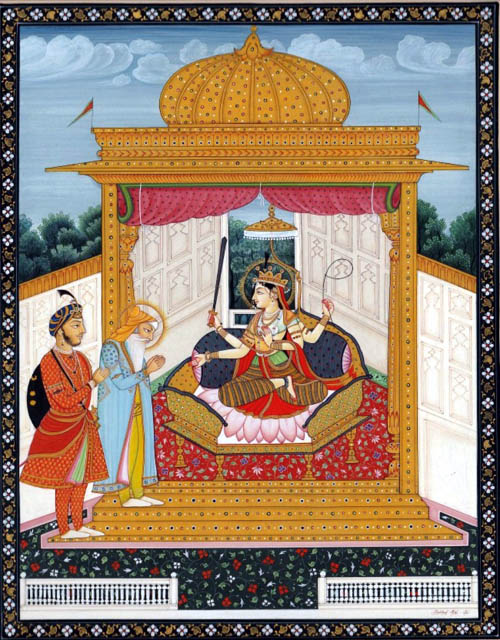
Maharaja Ranjit Singh
In A.D. 1805 the Gorkhas broke the treaty, and with an army of 40,000 soldiers crossed the river Sutlej, they were joined by the united army of (subdued) the hill rulers, which numbered 10,000 soldiers. Maharaja Sansar Chandra tried to re-assemble his original army but was unable to get it up to full strength.
The first encounter took place at the fortified palace of Mahal Morian. Maharaja Sansar Chandra and his army fought very bravely but were defeated.
The second encounter was at Nadaun where the newly acquired army of Rohillas were defeated (the Raja of Mandi was liberated from his prison in Nadaun). A new boundary was set on the river Beas & Maharaja Sansar Chandra took up his position at Tira Sujanpur.
For two years both sides invaded each others' territories, this resulted in the migration of people from this area into other states. In A.D. 1808, the Gorkhas struck a decisive blow and captured the fort of Pathiyar (Palampur). On receiving this report Maharaja Sansar Chandra took his family to Kangra fort. The Fort of Kangra had been well armed and rationed by Maharaja Sansar Chandra and it is believed that there were enough provisions in the fort to last for 12 years. All the rulers who had been subdued by Maharaja Sansar Chandra were given independence. The Gorkha army advanced towards Kangra and for four years they besieged the fort, but to no avail.
The supplies within the fort (due to bad management) were running out and drastic action had to be taken. Maharaja Sansar Chandra, secretly opened talks with Maharaja Holkar (Maratha noble) who was in Punjab at the head of an 25,000 strong army.
A conspiracy was decided between the Maharajas. It was decided that Maharaja Sansar Chandra would invite Maharaja Ranjit Singh of Punjab to fight the Gorkhas. Once the Gorkhas and the Sikhs had finished fighting, the victor of the two would be too weak to fight the combined armies of the Holkars and the Katochs. This would make the two Maharajas (Holkar and Kangra) the Lords of the Himalayas and Punjab (the lands and booty captured after the war would be shared between the two).
Plans of this conspiracy were known only to a trusted few and they were put in-charge of implementing the plan. Maharaja Ranjit Singh was invited to give battle to the Gorkhas. It is said that he left Lahore twice (for Kangra) but turned back. In A.D. 1809, Maharaja Ranjit Singh reached Jwalamukhi and camped at the Katoch fort of Jwalgarh. Maharaja Sansar Chandra who left the Kangra fort (at night dressed as a peasant) and went to meet Ranjit Singh. They both signed a treaty which read that in the case of Gorkhas being driven out of Kangra - Maharaja Sansar Chandra will surrender the fort of Kangra along with the 76 villages which formed the ancient jagir of the fort (for its maintenance) to Maharaja Ranjit Singh the rest of the Kangra state will be delivered to Maharaja Sansar Chandra without any further conditions.
In August A.D. 1809, Maharaja Ranjit Singh attacked the Gorkhas, who had been greatly reduced in numbers due to cholera. The Gorkhas fled without a fight and were driven out as far as the river Gogra (where they were further defeated by the British).

Maharaja Sansar Chandra entering Bilaspur with his army (trained by the Irish Col. O. Brian)
Maharaja Sansar Chandra now waited for the Holkar army to attack the Sikhs, but this never happened because the Holkar army was not ready to face the relatively fresh (not war wary) Sikh army.
Under these circumstances Maharaja Sansar Chandra now faced even a bigger enemy than the Gorkhas and decided not to fight but instead stand by the treaty he had signed. On 24th August, A.D. 1809, the fort of Kangra was handed over to the Sikhs, for a few years the treaty was honored and Maharaja Sansar Chandra was treated with great respect (as equals). But as the years passed Ranjit Singh became less considerate towards his once powerful rival, (this change of attitude was due to the facts that Ranjit Singh had been informed of the conspiracy which was planned between the Maharajas of Kangra and Holkar).
Mr. Moorecoft and Mr. Tredeck visited Kangra in A.D. 1820, and stayed at the court of Maharaja Sansar Chandra. They recorded the following:- "In the evening I waited upon the Maharaja and found him in an open building in the garden, with his son and grandson. The Maharaja is a tall and well formed man. He was formally the most powerful Maharaja from the Sutlej to the Indus River.
He was extremely wealthy, possessing revenue of 35 lac rupees. The loss of most of his territories to Ranjit Singh has reduced his revenue to almost Rs. Nine lac per year.
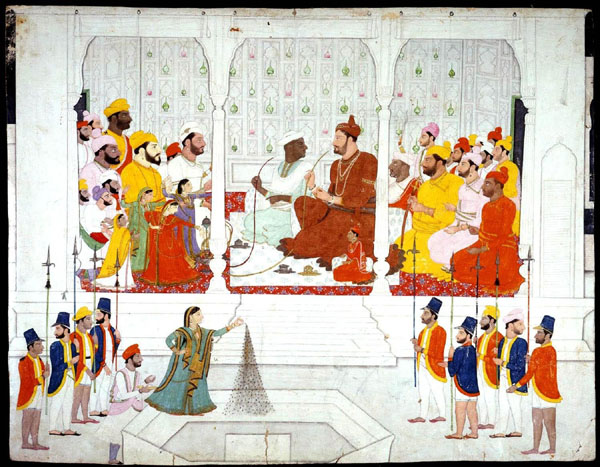
Maharaja Sansar Chandra holding court
His resources are however, still respectable, his country strong and warmly attached to him. He has a large property in jewels and arms, which can be turned to better account, but his pride however, prevents him from doing so. He is very anxious to be taken under the protection of the British Government."
Moorecoft, while at Sujanpur cured Raja Fateh Chandra (Raja of Rajgir Lambagraon, younger brother of Maharaja Sansar Chandra he controlled the forts of Bijapur, Ashapuri, Chauki Lambagraon and Baijnath) from a fatal illness. Moorecoft was greatly respected for this feat and was showered with presents. Fateh Chandra and Moorecoft exchanged their hats and became brothers.
Moorecoft further narrates "Since the loss of Kangra, the Maharaja stays more with his large Zenena at Alampur and spends the day in the fort of Tira Sujanpur where the apartments are more spacious and commodious than usually found in any other Indian Palace. These rooms are now used for the Maharaja's personal treasury and armory in which there are some splendid swords." Moorecoft also gives us an idea of the size of the Maharaja Sansar Chandra state which after the treaty with Ranjit Singh was about 7,000 sq. miles and is divided into three provinces Katoch, Changar, Palam. Moorecoft also speaks of two Irish men in the services of Maharaja Sansar Chandra (they were deserters from the East India Company). Col. O'brian and a younger man James, they had trained an army of 1400 soldiers on the European lines. They designed blue Georgian uniforms for these soldiers (the Scindias too, in this period established an European army, commanded by a French general. This army raged havoc in the Rajputana). They also established a factory which produces small fire arms and cannon. "These men are of great use to the maharaja and had they more resources they would have been of even more use. This army of 1400 soldiers had been used by Maharaja Ranjit Singh on many campaigns. But most importantly, Moorecoft tells us about the bronze plate he was with the Maharaja and was told that the origin of this plate is uncertain but the Maharaja had inherited it as a family Heirloom. "It has Greek inscriptions on one half and on the other half there is a profile of a face which is said to be that of the great conqueror Alexander."
Maharaja Sansar Chandra died in December, A.D. 1823 after a long reign of 47 years." (it is interesting to note that the average reign of a Katoch monarch till A.D. 1947 was 17 years).
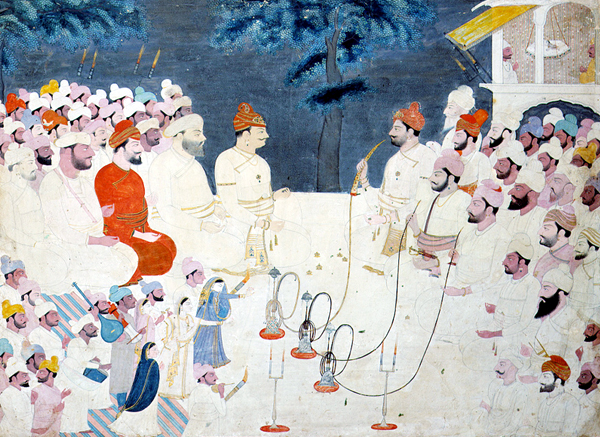
Kangra Durbar
He was in many respects a remarkable man and has left a record second to none as a ruling chief. Among Royal personalities of Indian his name stands out as a great ruler and a great patron of art (under him flourished the famous school of Kangra Miniature Paintings).
In A.D. 1823 Maharaja Rai Anirudh Chandra sat on the Gaddi, and for the recognitions of his investiture, he paid the Sikh court a sum of one lac twenty five thousand rupees. In return he received a suitable khilat.
Maharaja Anirudh Chandra was forced to attend Maharaja Ranjit Singh's court and was also made to establish his own haveli in Lahore. On one of those trips to Lahore in A.D. 1827, Ranjit Singh ordered Maharaja Anirudh Chandra to get his sister married to Hari Singh, son of Raja Dhian Singh of Jammu. His descendant during the British Raj became the rulers of the largest state in India and would become the only Rajput ruler entitled to a 21 guns salute. This demand was completely unacceptable, because the Jammu state was considered lower in status to that of the Kangra State.
The Katoch clan being the purest among all the Rajputs, and the royal family being Maharajas in their own right, unlike Dhian Singh who was a raja by the favor of his master. Nothing weighed more than the family's honor in the heart of the Katoch King. Maharaja Anirudh Chandra made secret arrangements with the British and a year later left his kingdom (without a king) and retired to Haridwar (the haveli and the temple established by him in Haridwar is called the Kangra Mandir and is still retained by the family). In Haridwar he got his sister married to the Raja of Tehri Garhwal (the rulers of Garhwal in the day of the Mughals were exempted from taxes, due to lack of revenues) and died shortly after. In his younger days (while his father was still alive) he and his wife established the palace at Lambagraon (one of the buildings in Lambagraon is called the Sard Khana this building was used in the summers and had basements which were filled by large chunks of snow brought all the ways from the mountains in order to keep the building cool).
There is an interesting story that gives us an account of the unfortunate incident that occurred with one of the daughters of Maharaja Anirudh Chandra. She was kidnaped by thugs and sold to the British Garrison, while escaping from Kangra. There she met Captain Lawrence and fell in love with him as she could not return to her family (because after being kidnaped she would not be accepted) she married captain Lawrence and went to England. The story written by Mrs. M. M. Kay "The far pavilions" is somewhat similar to this story.
Meanwhile at Kangra, Raja Fateh Chandra (younger brother of Maharaja Sansar Chandra) made alliances with Ranjit Singh. In return he was granted the Jagir of Changar along with his original jagir of Rajgir-Lambagraon.
Jodhbir Singh, (one of the illegitimate sons of Maharaja Sansar Chandra born from a Gaddan/Tribal woman) gave his two sisters to Ranjit Singh in marriage and in return was made the Raja of Nadaun. (These two girls committed Sati on Maharaja Ranjit Singh's funeral).
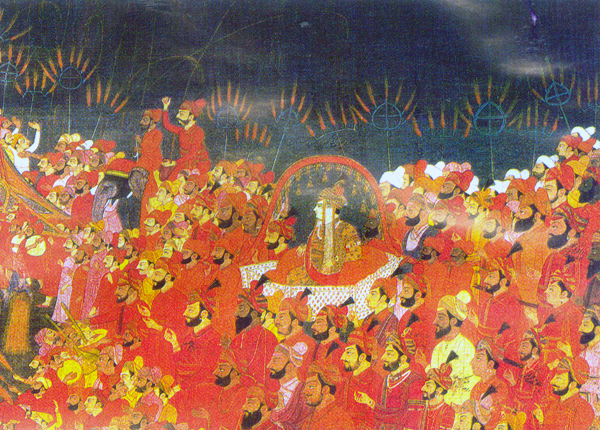
Maharaja Anirudh Chandra's Wedding procession
Raja Jodhbir Singh's mother had met Maharaja Sansar Chandra while he was out on hunting the story goes one day while out on shikar, Maharaja Sansar Chandra came upon this tribal woman. He was so enchanted by her beauty that he asked her whether she was an Apsara (fairy) from the heavens. To this she replied that she was not an Apsara but a tribal girl who lived in the village below. To this, Maharaja Sansar Chandra said, come with me to my palace and become my queen she replied that she was already happily married and did not wish to go to the palace. Maharaja Sansar Chandra was adamant and said that here you sleep on the ground and eat coarse rice while at my palace you will eat 36 varieties of food served on plates made of Gold and Silver, and you will sleep on beds made of Silver to which she said "O' Great King I am very happy in my hut with my husband and children". Maharaja Sansar Chandra was not a person who could take no for an answer he suitably compensated the girls husband to release her of her marriage and took her to his palace. For many days her ex-husband would come under the palace to graze his cattle, and look at his ex- wife who sat by the window. In a few years time she got used to the palace life and forgot about her past.
Because Raja Jodhbir Singh was not from pure lineage therefore, his descendants were not legal heirs to the throne of Kangra they were not allowed to use the surnames of Chandra Katoch and were not allowed to share a Hukka (pipe smoke) with the Katoch clan.
The rest of the Kangra State and the estates of the Kangra family in Lahore were confiscated by Maharaja Ranjit Singh and put under the charge of Sher Singh.

